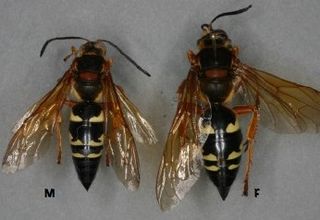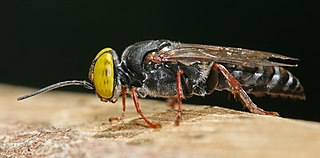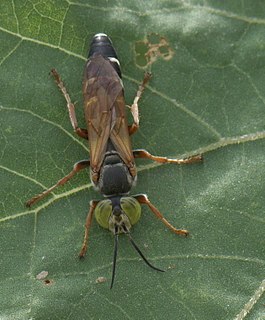
Sphecius speciosus, often simply referred to as the cicada killer or the cicada hawk, is a large digger wasp species. Cicada killers are large, solitary wasps in the family Crabronidae. The name may be applied to any species of crabronid which preys on cicadas, though in North America it is typically applied to a single species, S. speciosus. However, since there are multiple species of related wasps, it is more appropriate to call it the eastern cicada killer. This species occurs in the eastern and midwest U.S. and southwards into Mexico and Central America. They are so named because they hunt cicadas and provision their nests with them. In North America they are sometimes called sand hornets, although they are not hornets, which belong to the family Vespidae. Cicada killers exert a measure of natural control on cicada populations and thus may directly benefit the deciduous trees upon which their cicada feed.

The Crabronidae are a large paraphyletic group of wasps, including nearly all of the species formerly comprising the now-defunct superfamily Sphecoidea. It collectively includes well over 200 genera, containing well over 9000 species. Crabronids were originally a part of Sphecidae, but the latter name is now restricted to a separate family based on what was once the subfamily Sphecinae. Several of the subfamilies of Crabronidae are often treated as families in their own right, as is true of the most recent phylogenies.

Cicada killer wasps are large, solitary, ground dwelling, predatory wasps. They are so named because they hunt cicadas and provision their nests with them, after stinging and paralyzing them. There are 21 species worldwide. The highest diversity occurs in the region between North Africa and Central Asia.

Sphecius grandis, also called the western cicada killer, is a species of cicada killer wasp (Sphecius). The western species shares the same nesting biology as its fellow species, the eastern cicada killer. S. grandis, like all other species of the genus Sphecius, mainly provides cicadas for its offspring. It forms nest aggregations and mates and broods once in a year, in July and early August. The wasp is on average 3 cm (1 in) to 5 cm (2 in) in length and is amber-yellow with yellow rings on its abdomen.
Sphecius convallis, the Pacific cicada killer, is a species of sand wasp in the family Crabronidae. It is found in Central America and North America.
Bicyrtes capnopterus is a species of sand wasp in the family Crabronidae. It is found in Central America and North America.
Glenostictia pictifrons is a species of sand wasp in the family Crabronidae. It is found in North America.
Ammoplanops vierecki is a species of aphid wasp in the family Crabronidae. It is found in North America.
Eucerceris arenaria is a species of wasp in the family Crabronidae. It is found in North America.
Eucerceris superba is a species of wasp in the family Crabronidae. It is found in North America.
Cerceris tolteca is a species of wasp in the family Crabronidae. It is found in Central America.
Spilomena hainesi is a species of aphid wasp in the family Crabronidae. It is found in North America.
Philanthus solivagus is a species of wasp in the family Crabronidae. It is found in North America.
Ectemnius centralis is a species of square-headed wasp in the family Crabronidae. It is found in the Caribbean, Central America, and South America.

Tachytes distinctus is a species of square-headed wasp in the family Crabronidae. It is found in the Caribbean Sea and North America.
Didineis peculiaris is a species of wasp in the family Crabronidae. It is found in Central America and North America.

Microbembex monodonta, the sand bee, is a species of sand wasp in the family Crabronidae. It is found in the Caribbean Sea, Central America, North America, and South America.
Liris argentatus is a species of square-headed wasp in the family Crabronidae. It is found in the Caribbean, Central America, North America, and Oceania.

Bembecinus quinquespinosus is a species of sand wasp in the family Crabronidae. It is found in the Caribbean Sea, Central America, North America, and South America.

Bembix americana is a species of sand wasp in the family Crabronidae. It is found in the Caribbean Sea, Central America, North America, and South America.






